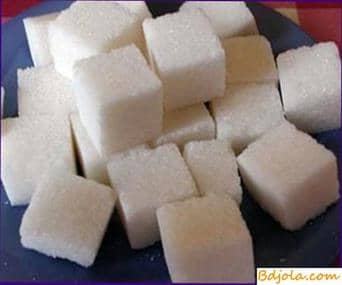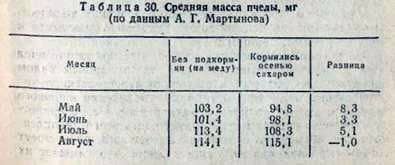
With a lack of honey in the hives, as well as to replace the poor quality honey (with a mixture of pade, rapidly crystallizing), bees are fed with sugar. In forest areas, where bees almost every year bring a certain amount of padi, 4-6 kg of sugar are given to bees for preventive purposes. In recent years, there has been a desire to reduce the cost of winter keeping bees by replacing honey with cheaper sugar. This required a more detailed study of sugar as a winter food for bees. The supply of bees with sugar food has its both positive and negative sides. Sugar feed in the process of digestion in bees forms very little feces, much less than good floral honey. According to the experiments conducted in different winters, the weight of the hindgut in the spring before flying was on average: honey bees – 34.0 mg, fed with sugar food, 25.3 mg. This is a significant difference, which reflects a much better wintering of bees on sugar fodder. However, when feeding bees a lot of sugar, they consume a lot of nutrients and energy for its processing. Now it is well known that the autumn generation of bees (going into winter) differs from summer ones by a whole series of signs, of which the most important are the accumulation of nutrients in the body, the increase in the fat body, and the reduction of free water in the body. For the processing of sugar syrup, bees spend part of this accumulated nutrient reserve for the winter, even they can use it completely from the fall, which reduces their capacity for work in the spring and can lead to death in winter or early spring. In addition, bees, hibernating on sugar, absolutely do not get protein from food and therefore consume a stock of protein in the body. The decrease in protein in the body of bees by the spring reduces the ability of them to rear the brood. The families of bees, who ate only sugar in winter and spring, fed less brood (Table 29).
Accordingly, the strength of these bee families in spring turned out to be less. The Institute of Apiculture determined the influence of autumn feeding of bees with sugar on their subsequent wintering, spring growth and productivity. The bees’ families, who received 10-12 kg of sugar top dressing, had better winter than the families on honey, but in the spring and in the first half of the summer they lagged behind in brood rearing compared to families that wintered on honey without additional fertilizing. They proved to be much lower and the quality of the bees, which had less enzyme activity and grew smaller bees (Table 30).

During the spring-summer season, in the presence of honey as the generation of bees changed, the mass of families and the average weight of individual bees increased. By the time of late honey collection with buckwheat, the families were leveled and collected an average of 33.0 kg (for honey) and 30.7 kg (on sugar) per family. The later the main honey crop comes, the more the families are weighed, weakened by sugar feeding in autumn. Families that winter on sugar, at the end of winter and early spring, especially need replenishment of protein stores in the body. Therefore it is necessary to leave in the nest of each family from autumn on 2-3 honeycombs with perga, placing them before the beginning of feeding bees to the second places from the edges. Experiments have noted that bee families who had pengu in winter grow more brood in the spring than equal in strength to the family, wintering without pergie and receiving honeycomb with perga immediately on the day of the exhibition from the winter hut. The bees begin to consume pollen in February, and its absence in the nest causes their anxiety and more wear. The club of bees that do not have Perga, before loosens, it reduces the carbon dioxide content, which is an indicator of the deterioration of wintering. In spring such bees die faster, families weaken and grow brood less. Especially acute is the issue with the autumn feeding of patients with varroatosis of bees. At the end of the crop, the number of brood in the nests of bees is reduced, the cultivation of drones ceases. As a result, the concentration of ticks in the bee brood and the harm they cause to the developing bees are increasing. And at this time the generation of bees going to winter is just being deduced, and it is exposed to a greater influence of ticks than the bees of previous generations. They can not accumulate additional reserve nutrients and other substances, necessary for wintering. Ticks inflict especially severe harm to bees going to winter, preventing the withdrawal of physiologically valuable individuals. And if such families still feed sugar in the fall, the bees will be so weakened that they will not be able to endure the winter. Therefore, the main struggle with mites should be carried out in spring and summer, before the main honey crop, and varroat families should only be fed with sugar in a small amount and only in the most necessary cases – if there are poor quality honey in the nests, and when, due to weak honey harvest, families do not have enough feed for the winter. Relaxed families should be given ready-made honeycombs with sealed food. Consequently, in the autumn families of bees have a lot of sugar (12-15 kg) only in extreme cases, when it is necessary to save bees, who collected a lot of honeydew honey, not providing themselves with sufficient fodder reserves. Prophylactic fertilization with sugar in the amount of 4-6 kg of bees is tolerated painlessly, but it needs to be fed so that bees feed on sugar only in the winter months, and from early spring they switch to honey food. In all cases it is necessary to leave 2-3 honeycombs with perga in the hives.
Ивовый мед. Карликовые пчелы.
Feeding base of beekeeping